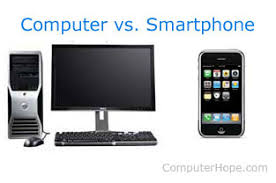Smartphones vs. Laptops: The Battle for Mobile Dominance
The ongoing battle between smartphones and laptops for mobile dominance has defined technological progress over the last decade. Both devices have evolved significantly in terms of processing power, portability, and functionality, each catering to different aspects of productivity, communication, and entertainment. As technology advances, the line between these two devices continues to blur, leading to debates about which will emerge as the superior tool for the future of mobile computing. This article delves into the key factors shaping this competition: portability, performance, battery life, user experience, and the future of mobile technology.
1. Portability: The Defining Factor
The primary distinction between smartphones and laptops is their size and portability. Smartphones have a clear edge in terms of mobility, as they are lightweight and compact, easily fitting in pockets or small bags. This has made smartphones the go-to device for on-the-go use, allowing users to stay connected, browse the web, and use apps wherever they are.
a. Smartphones: Ultra-Portable Powerhouses
Smartphones have become indispensable tools in daily life due to their ease of use and ultra-portability. With most devices weighing under 200 grams and boasting screens between 5 to 7 inches, smartphones offer unmatched convenience for users who prioritize mobility. In recent years, manufacturers have introduced foldable smartphones, such as the Samsung Galaxy Z Fold and Huawei Mate X, offering larger displays without compromising on portability. These advancements give smartphones an edge over laptops in terms of mobility, making them an essential part of everyday life.
b. Laptops: Portable, but with Trade-Offs
While laptops are larger and less portable than smartphones, they are still considered mobile devices, particularly ultrabooks and 2-in-1 convertibles that weigh around 1 to 2 kilograms. Laptops offer larger screens, full-size keyboards, and the ability to perform more demanding tasks. However, carrying a laptop requires a dedicated bag or case, and using it in confined spaces, like public transport or cafes, can be less convenient than using a smartphone. Despite being bulkier, laptops provide a balance between portability and functionality for users who need a more powerful, multitasking machine.
2. Performance: Processing Power and Capabilities
When it comes to performance, laptops have traditionally outpaced smartphones, offering superior processing power, larger memory, and the ability to handle more demanding applications. However, as smartphones become more powerful, the performance gap between the two is narrowing.
a. Smartphones: Closing the Gap
Smartphones have made significant strides in terms of performance over the years, with flagship devices like the Apple iPhone 15 Pro, Google Pixel 8, and Samsung Galaxy S23 Ultra sporting processors that rival some laptops. Advanced chipsets like Apple’s A17 Bionic and Qualcomm’s Snapdragon 8 Gen 2 have enhanced the computational capabilities of smartphones, enabling them to run graphically intensive games, multitask efficiently, and support augmented reality (AR) and artificial intelligence (AI) applications.
However, despite these improvements, smartphones are still limited by their form factor, which restricts cooling capabilities and battery capacity. This means that for tasks requiring heavy-duty performance—such as video editing, 3D rendering, or running full desktop applications—laptops remain the better option.
b. Laptops: Still the Powerhouses
Laptops, particularly those designed for professionals and gamers, offer far superior processing power compared to smartphones. High-end laptops equipped with Intel Core i9 or AMD Ryzen 9 processors, along with dedicated GPUs like NVIDIA RTX 4000 series, can handle intensive tasks such as video editing, gaming, software development, and data analysis. Laptops also benefit from larger RAM capacities (up to 64 GB or more) and storage options, making them the go-to choice for users who require high performance and multitasking abilities.
While laptops are larger and heavier, their processing power remains unmatched for professional and creative work, making them indispensable for users in fields such as graphic design, animation, and engineering.
3. Battery Life: Efficiency vs. Power
Battery life is a crucial consideration when choosing between smartphones and laptops, especially for users who need their devices to last throughout the day without constant recharging.
a. Smartphones: Designed for Efficiency
Smartphones generally offer longer battery life than laptops due to their lower power consumption. With modern devices equipped with energy-efficient processors and optimized operating systems, flagship smartphones can last between 10 to 20 hours of continuous use on a single charge. Features like fast charging and wireless charging further enhance the user experience by allowing quick and convenient recharges.
However, battery life can vary significantly depending on usage. Streaming video, playing graphically intensive games, or using location-based services like GPS can quickly drain a smartphone’s battery. Nevertheless, smartphones generally offer a more reliable all-day battery life compared to laptops, especially when used for lighter tasks like texting, browsing, and social media.
b. Laptops: Balancing Power and Battery Life
Laptops typically consume more power than smartphones, especially when running resource-intensive applications. However, advances in battery technology and energy-efficient processors have significantly improved laptop battery life in recent years. Ultrabooks and productivity-focused laptops, such as the MacBook Air M2 and Dell XPS 13, can now deliver between 10 to 18 hours of battery life, depending on usage.
Gaming laptops and workstations, which are designed for heavy performance, generally have shorter battery life due to their high power consumption. While laptops offer more power and versatility, they often require more frequent charging than smartphones, especially during intensive use.
4. User Experience: Interfaces and Ecosystems
The user experience is a significant differentiator between smartphones and laptops. Each device excels in different areas, depending on the task at hand and the user’s preferences.
a. Smartphones: Intuitive and Integrated
Smartphones offer an intuitive, touch-based interface that is optimized for quick and easy interaction. Mobile operating systems, such as iOS and Android, provide seamless navigation through apps and services with minimal learning curves. The rise of app ecosystems has made smartphones essential for social media, gaming, banking, and shopping, with each platform offering a plethora of specialized apps designed for convenience and mobility.
Smartphones are also deeply integrated into cloud-based ecosystems. Services like Google Drive, iCloud, and Microsoft OneDrive allow users to sync their data across multiple devices, ensuring that their files, photos, and documents are accessible from anywhere. Voice assistants, such as Siri and Google Assistant, further enhance the mobile experience by enabling hands-free interaction and personalized recommendations.
However, for complex tasks like coding, large-scale document editing, and detailed graphic design, the small screens and limited input options of smartphones can be a hindrance.
b. Laptops: Productivity and Multitasking
Laptops excel in tasks that require productivity, precision, and multitasking. Their full-size keyboards, larger displays, and multitouch trackpads make them the ideal choice for users who need to write, edit, or create complex content. Laptops also support multiple windows and multitasking with ease, allowing users to run several applications simultaneously.
In terms of software, laptops offer access to full desktop applications like Microsoft Office, Adobe Creative Suite, and professional-grade development tools. The flexibility of laptops makes them indispensable for professionals in fields that require heavy computing, detailed visual work, or complex multitasking.
Laptops are also capable of running full operating systems, such as Windows, macOS, or Linux, which offer greater customization and control compared to mobile operating systems. For advanced users, this makes laptops the preferred device for productivity and creativity.
5. The Future of Mobile Dominance: Convergence or Competition?
As both smartphones and laptops continue to evolve, the question remains: Will one device ultimately replace the other, or will they continue to coexist?
a. Smartphone-Laptop Convergence
One possible future for mobile computing is the convergence of smartphones and laptops into hybrid devices. As smartphones become more powerful, with foldable screens and enhanced processing capabilities, they may eventually offer laptop-like functionality without the need for separate devices. Already, products like Samsung DeX allow users to connect their smartphones to external monitors, transforming their phones into desktop-like computing environments.
Conversely, laptops are incorporating more smartphone-like features, such as touchscreen displays, always-on connectivity (through 5G), and improved portability with 2-in-1 designs. Devices like Microsoft Surface Pro and Lenovo Yoga blur the lines between laptops and tablets, providing both the power of laptops and the convenience of touchscreens.
b. The Role of AI and Cloud Computing
Artificial intelligence (AI) and cloud computing are likely to play a significant role in the future of mobile computing. AI-powered virtual assistants, predictive typing, and smart recommendations are becoming more common across both smartphones and laptops, enhancing user experiences by offering more personalized and efficient interactions.
Cloud computing further bridges the gap between smartphones and laptops by allowing users to access their files and applications from any device, regardless of its form factor. As cloud services become more powerful, the need for high-performance local devices may diminish, making lightweight and portable devices more attractive.
Conclusion
The battle for mobile dominance between smartphones and laptops is likely to continue for the foreseeable future, with each device offering distinct advantages and catering to different user needs. Smartphones are unrivaled in portability, convenience, and integration with modern ecosystems, while laptops provide superior performance, productivity, and multitasking capabilities.
As technology evolves, the lines between these devices may blur even further, with hybrid devices, AI, and cloud computing driving the next wave of innovation. For now, smartphones and laptops will continue to coexist, each dominating its respective domain in the world of mobile computing.


